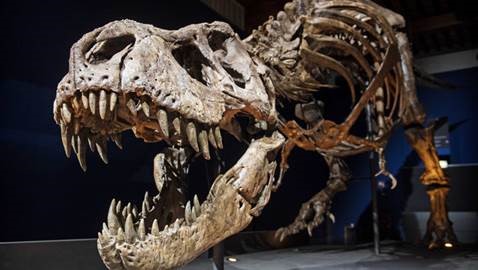Guest post by Claire van Teunenbroek, 3rd year PhD student at the Center for Philanthropic Studies at VU University. You can read more about Claire’s research on her blog here.
Trix the T.rex: a successful Dutch crowdfunding project
A long time ago far away from Amsterdam, ‘Trix’ the Tyrannosaurus (T-rex) roamed the earth. She stood twelve meters tall, weighed five thousand kilos and had more than 50 sharp teeth of about 20 centimetres long. These days, the T-rex skeleton (lovingly dubbed “Trix,” which is a common Dutch pet name and the nickname for our previous queen) travels through Europe thanks to more than 23,000 Dutch donors. After the tour, the T-rex will be on permanent display at the Naturalis, a Dutch museum of Biodiversity.
The bones of this beautiful female T-Rex, who lived about 66 to 67 million years ago, were found in Montana, USA during an expedition in 2013. When the cost to collect all the bones and ship them to the Netherlands proved to be too high, the museum started a charitable campaign to collect money to make their dream of displaying a complete T-rex skeleton come true.
Crowdfunding: transparent, democratic and full of rewards
Fortunately for the museum, much of the Dutch population shared their dream and were more than willing to contribute small donations to the cause. The museum decided to launch a crowdfunding campaign and assembled 5 million Euros in mostly small donations (e.g. most donors gave 10 euros).
Online crowdfunding developed in 2006, primarily in the arts and creative-based industries. One of the first crowdfunding platforms was the music oriented platform Sellaband, developed in the Netherlands in 2006. Crowdfunding is an increasingly applied instrument; the reward-based crowdfunding platform Voordekunst hosted 712 projects with a success rate of 81% and 40.107 donors contributed a total donation amount of €3.558.549.

An interesting characteristic of crowdfunding is the transparent nature of the funding tool: the solicitor provides a detailed description of how they will use the funds up front. In the case of our T-rex, the museum had to describe where Trix would be displayed. And because crowdfunding engages more people, it could be described as more democratic than previously used door-to-door campaigns. By donating to the T-rex cause, the Dutch donors were able to validate the campaign to bring Trix to the Netherlands.
Why is the transparency of crowdfunding important?
Worldwide, donors are more critical and conscious about the effect of their donation and expect non-profits to be more open both before and after receiving the donation. Non-profits that are more transparent about how the funding will be used to have an impact attract more donors. Moreover, are increasingly involving their donors in conversations and letting the donors take leadership in deciding which projects to start.
Why is the democratic factor in crowdfunding important?
Maintaining transparency after a donation is made is just as important, reflecting a shift from the donor as ‘giver’ towards ‘contributor.’ More than ever, individuals want to do more than opening their wallets, they want to be included and expect some form of a lasting relationship after the donation is made that allows the donor to observe the lasting impact of their donation.
Crowdfunding for the cultural sector in the Netherlands
In the Netherlands, it is not uncommon or new for the cultural sector to turn towards philanthropy as a method of financial survival. Financial aid in the form of donations for the cultural sector can be traced back as far as the Golden Age, when a group called the Maecenas started to financially support cultural institutions and individual artists.
After the financial crisis of 2008, the Dutch economy faced important challenges. First, the government was forced to decrease spending, which especially impacted the cultural sector, which had been heavily dependent on government subsidies.

However, the increasing pressure on philanthropic sources might not be ideal for the cultural sector. Most Dutch individuals (93%) judge the cultural sector as an unimportant goal for the general public. Not surprisingly, the cultural sector receives few donations (12% of the Dutch households donate to cultural projects). In an attempt to fill the financial gap, the government has encouraged an increased support from the third sector. For example, to stimulate donations to cultural projects, the Dutch government multiplied donations made to cultural institutions. However, this strategy did not result in more donations.
Crowdfunding as the next step?
Crowdfunding will not solve all the funding problems of the third sector, but this new funding tool could help to increase the reach of charitable organizations. I think that crowdfunding is a logical next step for the non-profit sector as government support decreases because crowdfunding is a relatively cheap method for reaching a large crowd. Also, it might attract new donors who are more critically about the return on their investment and are concerned about impact and transparency. More practically, crowdfunding connects with the current lifestyle of donors who spend daily time online.
Still, the impact of crowdfunding in charity is relatively small; in 2011 only 9% per cent of the Dutch population contributed online to charity organizations. Amounts raised through crowdfunding increase, but they account for less than 1% of giving in the Netherlands.
Trix will be on display at the Museum National d’Histoire Naturelle in Paris during the ISTR Conference (she is currently in Barcelona), but we hope you will come back and visit in 2019 when the museum reopens.


Reblogged this on Claire van Teunenbroek, PhD. Candidate and commented:
As of May 2018 I’m an official blogger for several sites. This blog is featured by ISTR.
LikeLike